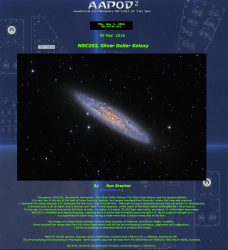NGC253, The Silver Dollar Galaxy
Click image for full size version
February 28, 2016 – Collaboration with Brett Soames; AAPOD May 5, 2016; BBC Sky at Night Hotshot of the Month, May 2016

 This galaxy, NGC253, has several nicknames: The Silver Dollar Galaxy, The Silver Coin Galaxy, and the Sculptor Galaxy. It is very low in the sky at the best of times from my location, but passes overhead from Australia, where this data was acquired. I observed this object through a 6″ telescope the last time I was in Costa Rica. Although it doesn’t show the colours that are evident in photographs, it showed quite a lot of detail, and is obvious and “bold” in the eyepiece, unlike many of the faint, barely-there galaxies I often look at. On the sky, it is almost as long as the full Moon is wide. In reality, it is about 70,000 light years wide, and about 11 million light years away. NGC253 is classified as a starburst galaxy, meaning there is active star formation occurring within it. At its centre is thought to be a supermassive black hole, having a mass more than 5 million times that of the Sun. In the faint halo around NGC253, and elsewhere in the image, you’ll find dozens of other galaxies.
This galaxy, NGC253, has several nicknames: The Silver Dollar Galaxy, The Silver Coin Galaxy, and the Sculptor Galaxy. It is very low in the sky at the best of times from my location, but passes overhead from Australia, where this data was acquired. I observed this object through a 6″ telescope the last time I was in Costa Rica. Although it doesn’t show the colours that are evident in photographs, it showed quite a lot of detail, and is obvious and “bold” in the eyepiece, unlike many of the faint, barely-there galaxies I often look at. On the sky, it is almost as long as the full Moon is wide. In reality, it is about 70,000 light years wide, and about 11 million light years away. NGC253 is classified as a starburst galaxy, meaning there is active star formation occurring within it. At its centre is thought to be a supermassive black hole, having a mass more than 5 million times that of the Sun. In the faint halo around NGC253, and elsewhere in the image, you’ll find dozens of other galaxies.
This image is a collaboration between me and Brett Soames, of Bathurst, New South Wales, Australia. Brett acquired the image data from his home observatory and did the pre-processing (calibration, alignment and integration). I did the processing as described below to produce this image.
Tekkies:
SBIG ST-6303E camera, Astrodon Gen2 LRGB filters, Custom-built 150mm f/11.1 refractor, Paramount ME. All pre-processing and processing in PixInsight. Brett Soames acquired the data from his observatory in Bathurst, New South Wales, Australia.
8x15mR, 8x15mG, 8x15mB and 77x15mL unbinned (total = 25hr15m)
RGB:
Creation and cleanup: R, G and B were combined to make an RGB image which was cropped and processed with DBE and ColourCalibration.
Linear Noise Reduction: MultiscaleLinearTransform was used to reduce noise in the background areas of the RGB image. Layer settings for threshold and strength: Layer 1: 3.0, 0.5 Layer 2: 2.0, 0.39 Layer 3: 1.0, 0.25 Layer 4: 0.5, 0.1. A mask was used to protect high signal areas.
Stretching: HistogramTransformation was applied to make a pleasing yet bright RGB image.
Luminance
Cleanup: The L master was cropped to match the RGB and DBE was applied.
Deconvolution: A copy of L was stretched to use as a deconvolution mask. A star mask was made from unstretched L to use as a local deringing support. Deconvolution was applied (80 iterations, regularized Richardson-Lucy, external PSF made using DynamicPSF tool with about 20 stars; local deringing at 70% and global dark deringing at 0.02).
Linear Noise Reduction: MultiscaleLinearTransform was applied to reduce the noise. Layer settings for threshold and strength: Layer 1: 3.0, 0.5 Layer 2: 2.0, 0.35 Layer 3: 1.0, 0.25 Layer 4: 0.5, 0.15
Stretching: HistogramTransformation was applied to make an image with similar brightness to the RGB image. TGVDenoise was applied and the image was re-stretched to reset the black point.
Combining SynthL with RGB:
The luminance channel of the RGB image was extracted, processed and then added back into the RGB image as follows:
1. Set RGB channels equal using RGBWorkingSpace.
2. Extract luminance from the RGB image.
3. Apply LinearFit using SynthL as the reference.
4. Use ChannelCombination in Lab mode to replace the RGB’s luminance with the fitted luminance from step 2.
5. LRGBCombine was then used to make a LRGB image using L as the luminance channel.
Final Processing
UnsharpMask was applied to the galaxy using a mask. MorphologicalTransformation was used to reduce the size of the brightest stars, followed by a hue adjustment to reduce a pink cast in a few bright stars. Contrast, brightness and colour saturation were adjusted in several iterations with the Curves tool, with separate adjustments were made for galaxy, background and stars using a mask. At the suggestion of a couple of fellow astrophotographers, the entire image was brightened slightly to reveal more of the faint halo around the galaxy.
Image scale is about 1.1 arcsec per pixel for this camera / telescope combination.







Leave A Comment